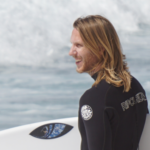My name is Jason. I am a software engineering leader, I like to surf and I love going on adventures in my camper van with my wife and dog.
How To Pop Up on a Surfboard?
Like I mentioned in the previous article, there are 3 fundamentals in surfing that you need to learn about and understand before you start catching waves – paddling, the pop up, and proper stance. If you missed any of the previous articles, go back and read through those first. In this article, I’m going to teach you how to pop up on a surfboard and share with you a few different ways you can practice.
The pop up is one of THE most important aspects in surfing. It’s what gets you off your stomach and onto your feet so you can shred those waves. You will struggle to find a good surfer who hasn’t perfected their pop up, so I encourage you to practice, practice, practice so that you can rely on muscle memory once you are out in the water. Alright, enough background – let’s get to it.
First, make sure you are in the right spot on your board. You shouldn’t be too far forward, and you shouldn’t be too far back. Your toes should be at the end of the board, you should still be in the same position that you’ve been paddling in. If you’ve stumbled across this article looking for help on a shortboard, you’ve already made a mistake – get yourself back to a longer board and work on your pop up before advancing.
Second, your head is up. Don’t stare at your board. Look where you want to go!
Third, place both hands FLAT on the surfboard next to your pecs/ribs with your shoulder blades pressed together. Your hands need to be back far enough, not too far forward or it will make popping up more difficult.
Don’t grab the rails, it creates an imbalance and causes drag in the water.
Now you’re ready to actually explode to your feet. In one fluid motion, with your back already arched, start to push up and move your feet forward underneath your body. Your feet should land in the center of your board – and by center I mean if there was an imaginary line running down your board nose to tail – it should go right through the middle of your feet. Your arms should stay in place until your up, and your front foot should land about where your hands were on the board.
Once your up, stay bent at the knees, don’t stand straight up. We’ll get into stance in the next article.
The pop up itself is going to take some practice to get used to. If you are really struggling with this version, there are two other methods that you can start with. Instead of doing one explosive pop up, you can cheat a little bit and slide your back leg up first to where your back foot is going to be and then place your front foot as you pop up. This is sort of an in between version of a pop up and might be helpful for beginners.
The other method is what I call the “knee first” version. While laying down, slide your back leg forward first onto one knee, place your front leg, and then stand up. Ideally you don’t want to be doing this, it’s way too slow for real waves. But for starting out in whitewash, this is ok and it can help you get used to paddling and getting in the right spot on your board.
Alright, so that’s the pop up and there are two ways you can practice this.
Option 1: Grab a foam board and put it on the ground with some blankets/padding underneath or bring it to the beach and build up some sand so you have a little bit of clearance for paddling. Placing the board on an angle can help simulate the wave a little bit better. Don’t use a fiberglass board for this, you’ll destroy it.
Option 2: Tape off your floor in the shape of a surfboard or use a yoga mat. You’ll want to tape a line down the middle of your yoga mat or pretend surfboard. That middle line will be helpful so you can tell where you are landing.
You want to always aim to be landing in the middle, you want your feet to be perpendicular to that line. The more off center you are, the harder it’s going to be to balance on an actual wave. So practice this over and over until you consistently are hitting the center with your feet.
The other thing to do while practicing is to pretend you are paddling before popping up. Really get in that mindset of paddle, paddle, paddle, pop up. Paddle, paddle, paddle, explode to your feet.
When you’re out in the water you don’t want to be overthinking things, so the more you do this at home, the easier it’s going to be.
If you are one of those people like me who needs a routine, wake up and do 10-15 good pop ups before you leave the house and do 10-15 popups at night. Make your practice sessions harder by only counting the ones where you land in the center. Keep in mind that once you start doing these in the water, it’s going to feel a bit different, but the muscle memory will help.
If you need help or tips with your pop up, feel free to leave a comment on my YouTube video or shoot me an email. In the next article, we’ll cover what your stance should look like and then we’ll be ready to go out and catch some waves!

